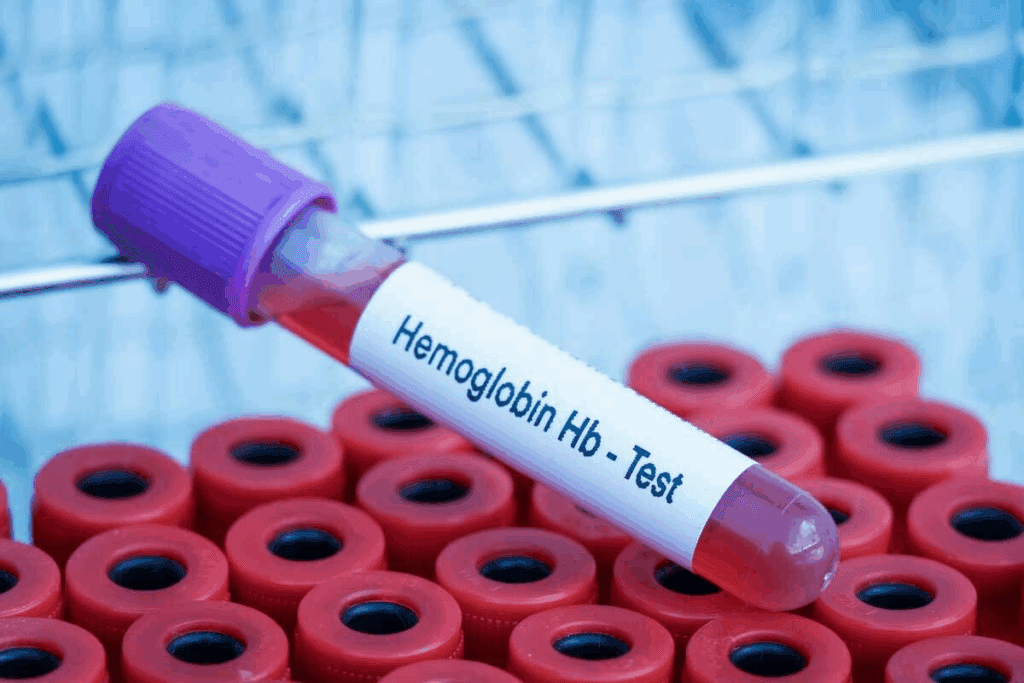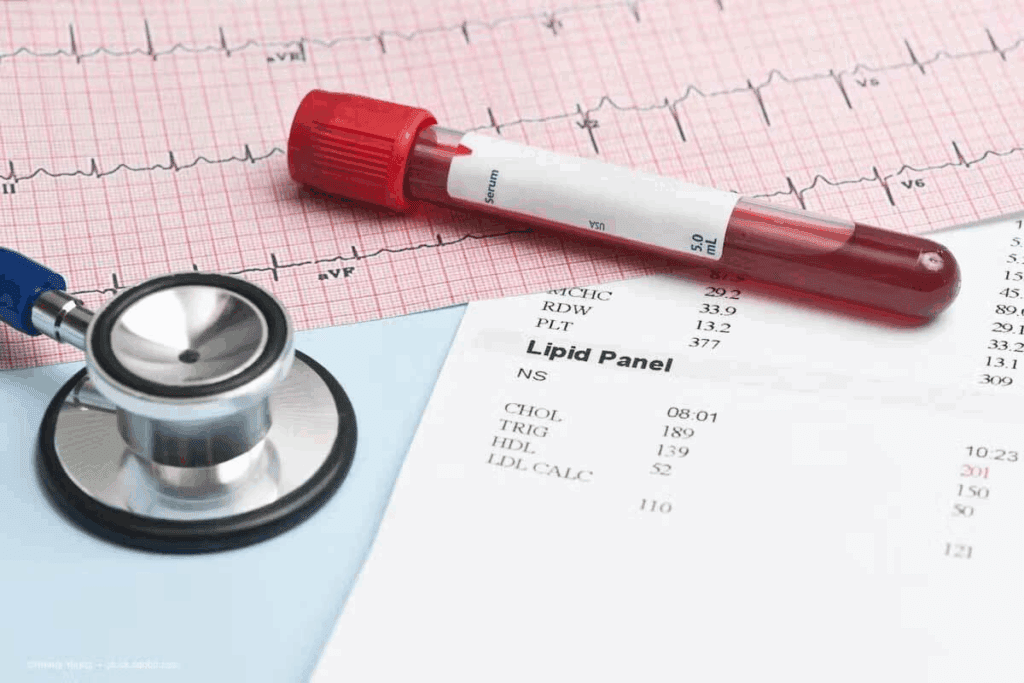Last Updated on November 14, 2025 by Ugurkan Demir
At Liv Hospital, we know how critical it is to tackle persistent anemia and its health effects. Low hemoglobin levels for a long time can cause serious, lasting damage if not treated.
Low hemoglobin, below 12 g/dL in women and 13.5 g/dL in men, often means you have anemia. We’ll look at what hemoglobin levels show anemia and the long-term risks.

Early detection and a team effort can greatly improve health for those with low hemoglobin. This article will dive into the important hemoglobin levels and their effects on long-term health.
Hemoglobin levels are key in spotting and treating persistent anemia. This condition lowers hemoglobin or hematocrit levels. It shows a drop in red blood cells in the body.
Persistent anemia means having less hemoglobin or hematocrit than normal. For men, it’s less than 13.5 g/dL, and for women, less than 12.0 g/dL. A blood test called a CBC measures these levels.
Key diagnostic criteria include:
Men and women have different normal hemoglobin levels. Men should have 13.5 to 17.5 g/dL. Women should have 12.0 to 16.0 g/dL.
Knowing these ranges helps diagnose anemia and see how severe it is.
| Gender | Normal Hemoglobin Range (g/dL) |
| Men | 13.5 – 17.5 |
| Women | 12.0 – 16.0 |
Checking hemoglobin levels is key to managing anemia. Regular tests help see how severe anemia is. They guide treatment and check if it’s working.
Benefits of monitoring include:

Understanding persistent anemia and its diagnosis is important. Knowing normal hemoglobin ranges and the need to monitor levels helps manage the condition. This improves patient care.
Anemia is divided into different levels of severity. This helps doctors understand how serious the condition is and plan the right treatment. The main way to measure anemia is by looking at hemoglobin levels.
The National Cancer Institute says anemia is graded as Mild, Moderate, Severe, and Life-threatening. Knowing these levels is key for diagnosing and treating anemia.
Mild anemia means your hemoglobin is just below what’s considered normal. For adults, this is usually between 10.0 g/dL and the normal lower limit. Even though symptoms might be small, it’s important to find and fix the cause to stop it from getting worse.
Moderate anemia has hemoglobin levels between 8.0 and 10.0 g/dL. People with this level may feel tired, weak, and have trouble breathing. Getting treatment at this stage can really help improve how you feel.
Severe anemia happens when hemoglobin levels fall below 8 g/dL. The National Cancer Institute says severe anemia is between 6.5 and 7.9 g/dL. At this point, symptoms like extreme tiredness, pale skin, and serious health problems can occur if not treated.
It’s very important to know how severe anemia is. This helps doctors choose the best treatment and improve patient results. By using hemoglobin levels to classify anemia, doctors can manage the condition better and address other health issues.
A hemoglobin level of 10.0 g/dL is considered borderline anemia. This is a condition that needs careful watching. At this level, people are just below the normal range. It’s a key time for early action to stop things from getting worse.
A hemoglobin reading of 10.0 g/dL shows the body isn’t making enough red blood cells or hemoglobin. This can lead to less oxygen getting to tissues and organs. Many things can cause this, like not getting enough nutrients, chronic diseases, or other health problems. Finding out why is key to treating it right.
People with borderline anemia might feel tired, weak, have pale skin, and breathe short. These signs can really affect daily life, making it hard to work or enjoy things. For example, being always tired can make simple tasks hard or take away the joy from activities you love.
“Anemia can have a profound effect on a person’s quality of life, making everyday tasks a challenge.”
-Specialists highlight.
Treatment for borderline anemia usually starts with fixing the cause. This might mean eating more iron, vitamin B12, or folate, or taking supplements if food alone isn’t enough. It’s important to keep checking hemoglobin levels to see if the treatment is working and make changes if needed. Sometimes, more tests are needed to find and treat other health issues.
We suggest talking to a healthcare provider to create a treatment plan that fits you. This way, you can manage borderline anemia well and stop it from getting worse.
Moderate persistent anemia means your hemoglobin is between 7.9-8.0 g/dL. This needs careful medical attention and lifestyle changes. At this level, symptoms can really affect your life.
A hemoglobin of 7.9 g/dL shows your body isn’t making enough hemoglobin. Or, you’re losing a lot of red blood cells. This is considered moderate anemia and needs a doctor’s check-up to find the cause.
“Anemia is not just a condition; it’s a signal that something is amiss in the body,” says a leading hematologist. “When hemoglobin levels drop to 7.9 g/dL, it’s vital to find the cause for the right treatment.”
Hemoglobin of 8.0 g/dL is just above 7.9 g/dL, but it’s also in the moderate anemia range. At this level, you might feel tired, weak, and short of breath. It’s important to keep an eye on these levels and adjust treatments as needed.
Treatment for moderate persistent anemia usually focuses on the cause. This could be iron or vitamin deficiency, or a chronic disease. Iron supplements are often given to help raise hemoglobin levels.
Managing moderate persistent anemia is not just about medical treatment. It also involves making lifestyle changes. Patients are told to:
By working with healthcare providers and making lifestyle changes, people with moderate persistent anemia can improve their hemoglobin levels and overall health.
When hemoglobin levels drop to 6.4-6.7 g/dL, the body faces severe anemia. This can lead to serious health issues. It can make it hard for the body to get oxygen to tissues and organs. This might cause heart problems, fatigue, and even death if not treated.
We will look at the health risks of such low hemoglobin levels. We will also talk about the medical steps needed to treat it.
A hemoglobin level of 6.7 g/dL is very low. People might feel very tired, weak, and have trouble breathing. This level of anemia is very serious. It shows the blood can’t carry enough oxygen.
At 6.5 g/dL, symptoms include dizziness, pale skin, and a fast heartbeat. These signs show the body is struggling to get enough oxygen. It’s very important to see a doctor at this point to find out why and how to treat it.
At 6.4 g/dL, you need to see a doctor right away. Treatment might include blood transfusions to increase red blood cells. It’s also key to find and treat the cause of anemia to stop it from getting worse.
Some signs need you to go to the doctor right away. These include:
If you or someone you know has these symptoms, get medical help fast.
When hemoglobin levels hit 5.8 g/dL, the body faces a serious health risk. At this point, anemia’s dangers grow, making quick medical help and treatment essential.
A hemoglobin level of 5.8 g/dL is a warning sign. It shows the body can’t carry enough oxygen to vital organs. This can cause serious health problems, like a fast heart rate, tiredness, and trouble breathing. In extreme cases, it might even lead to organ failure because of lack of oxygen.
Having a hemoglobin level of 5.8 g/dL comes with big health risks. People might feel:
These signs mean the body’s tissues and organs aren’t getting enough oxygen. This can lead to more serious problems if not treated quickly. Emergency Treatment Protocols
For a hemoglobin level of 5.8 g/dL, emergency care is needed. This usually means going to the hospital right away. The goal is to stabilize the patient and find out why they have anemia. Treatment might include:
Quick medical action is key to avoiding lasting harm and serious risks. It’s vital to get medical help fast if symptoms don’t get better or get worse.
Persistent anemia can harm many body systems if not treated. We’ll look at how anemia affects the body over time. This shows why finding and treating anemia early is key.
Anemia can badly affect the heart. Anemia can cause high-output heart failure. This makes the heart work too hard, leading to enlargement and failure.
It can also make heart problems worse. This can lead to chest pain and irregular heartbeats.
Anemia also harms the brain and thinking skills. It can make it hard to focus and remember things. In serious cases, it can even damage the brain.
This damage can be permanent if not treated quickly.
Anemia can also harm organs and the whole body. Renal failure is a risk because the kidneys need enough oxygen. Other problems include feeling tired, weak, and having a lower quality of life.
In severe cases, anemia can be deadly. The strain on the heart, brain damage, and organ problems can lead to serious health issues. We stress the importance of catching and treating anemia early.
Knowing how anemia affects the body over time is critical. Early action can prevent many problems. This helps improve health outcomes for patients.
Understanding persistent anemia is key to managing it well. This article covered many important points about anemia. We talked about what it is, how it’s diagnosed, and how severe it can be.
To manage anemia, you need to keep an eye on your hemoglobin levels. Knowing how severe your anemia is helps too. And, following the right treatment is essential.
Being aware of anemia and its risks is very important. This knowledge helps you stay healthy and avoid serious problems. Working with your doctor to find the best treatment is a big step towards a better life.
For adults, normal hemoglobin levels differ by sex. Men usually have levels between 13.8-17.2 g/dL. Women’s levels range from 12.1-15.1 g/dL.
A hemoglobin level of 10.0 g/dL is borderline anemia. It means the person is at risk of anemia. They might need monitoring and treatment.
Anemia severity is based on hemoglobin levels. It’s mild if levels are just below normal. Moderate is between 8-10 g/dL. Severe is below 8 g/dL.
Severe anemia at 6.5 g/dL causes fatigue and weakness. It also leads to pale skin, shortness of breath, and dizziness.
Yes, a hemoglobin level of 5.8 g/dL is critical and potentially life-threatening. It requires immediate medical attention and emergency treatment.
Persistent anemia can cause heart problems and brain damage. It can also harm organs and lead to cognitive issues if not treated.
Treatment for moderate anemia includes iron supplements and dietary changes. It also involves addressing the underlying causes and monitoring hemoglobin levels.
Yes, severe and prolonged anemia can be life-threatening. It can lead to death if not treated or managed properly.
Monitoring hemoglobin levels is key for diagnosing and managing anemia. It helps assess severity and guide treatment to prevent complications.
To manage anemia, increase iron intake and avoid tea and coffee with meals. Vitamin C supplements and other lifestyle changes can also help.
Subscribe to our e-newsletter to stay informed about the latest innovations in the world of health and exclusive offers!